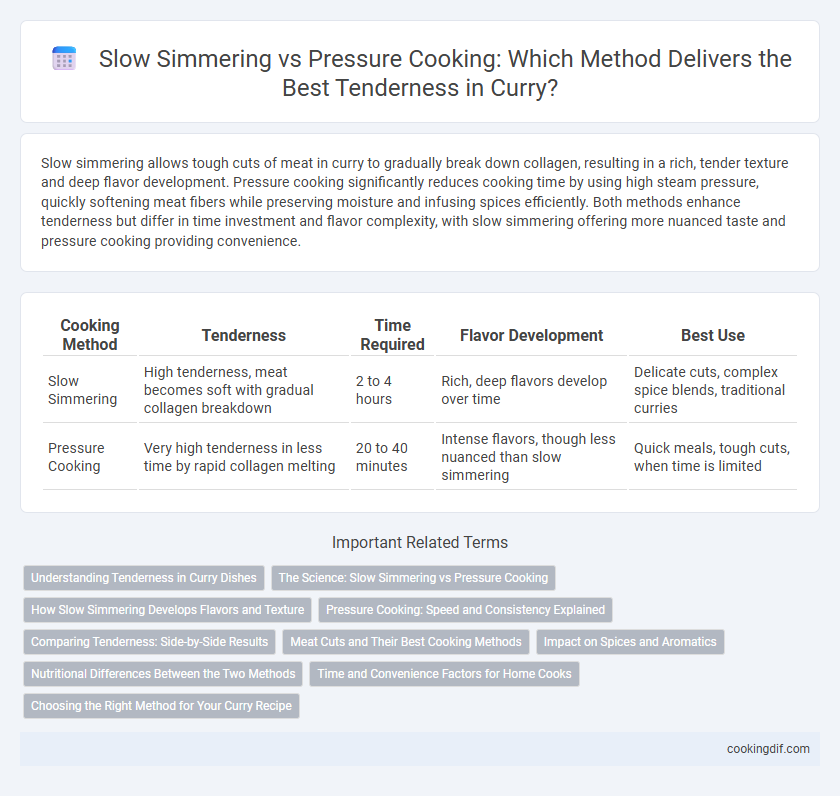Slow simmering allows tough cuts of meat in curry to gradually break down collagen, resulting in a rich, tender texture and deep flavor development. Pressure cooking significantly reduces cooking time by using high steam pressure, quickly softening meat fibers while preserving moisture and infusing spices efficiently. Both methods enhance tenderness but differ in time investment and flavor complexity, with slow simmering offering more nuanced taste and pressure cooking providing convenience.
Table of Comparison
| Cooking Method | Tenderness | Time Required | Flavor Development | Best Use |
|---|---|---|---|---|
| Slow Simmering | High tenderness, meat becomes soft with gradual collagen breakdown | 2 to 4 hours | Rich, deep flavors develop over time | Delicate cuts, complex spice blends, traditional curries |
| Pressure Cooking | Very high tenderness in less time by rapid collagen melting | 20 to 40 minutes | Intense flavors, though less nuanced than slow simmering | Quick meals, tough cuts, when time is limited |
Understanding Tenderness in Curry Dishes
Understanding tenderness in curry dishes hinges on breaking down connective tissues and fibers in meat, which is achieved differently by slow simmering and pressure cooking. Slow simmering allows collagen to gradually convert to gelatin over extended periods, resulting in a tender, flavorful texture with complex depth, especially in tougher cuts like beef or lamb. Pressure cooking accelerates this process by using high temperature and steam pressure to quickly break down proteins and gelatinize collagen, delivering tender results in a fraction of the time while retaining rich flavors and moisture.
The Science: Slow Simmering vs Pressure Cooking
Slow simmering breaks down collagen in meat gradually at temperatures just below boiling, resulting in tender textures through extended cooking times up to several hours. Pressure cooking reaches higher temperatures above 100degC by increasing pressure, accelerating collagen gelatinization and connective tissue breakdown within minutes. Both methods target collagen denaturation but differ in heat transfer, temperature control, and cooking duration, affecting moisture retention and flavor development in curries.
How Slow Simmering Develops Flavors and Texture
Slow simmering allows curry ingredients to gently break down over an extended period, enhancing the depth of flavors and creating a rich, well-balanced aroma. This method tenderizes meat by gradually dissolving connective tissues, resulting in a soft, melt-in-the-mouth texture that pressure cooking sometimes cannot replicate. The prolonged heat exposure also enables spices and herbs to fully infuse, producing a complex and layered taste unique to slow-cooked curries.
Pressure Cooking: Speed and Consistency Explained
Pressure cooking significantly reduces cooking time by using high steam pressure to tenderize tougher cuts of meat in curries, ensuring consistent texture throughout. The sealed environment traps moisture and heat, which breaks down collagen and connective tissues more efficiently compared to slow simmering. This method is ideal for those seeking quick, reliable tenderness without compromising the depth of flavor in slow-cooked dishes.
Comparing Tenderness: Side-by-Side Results
Slow simmering allows curry meats to break down gradually, resulting in a tender, melt-in-the-mouth texture with complex, well-developed flavors. Pressure cooking rapidly tenderizes tougher cuts by reaching high temperatures quickly, producing soft meat in a fraction of the time while retaining juiciness. Comparing tenderness, slow simmering yields deeper flavor infusion and delicate texture, whereas pressure cooking offers efficient tenderness with a slightly firmer bite.
Meat Cuts and Their Best Cooking Methods
Tough meat cuts like chuck roast or brisket develop optimal tenderness through slow simmering, which breaks down collagen gradually over several hours. In contrast, pressure cooking is ideal for moderately tough cuts such as pork shoulder or short ribs, significantly reducing cooking time while achieving similar tenderness by rapidly tenderizing connective tissues. Choosing between slow simmering and pressure cooking depends on the specific cut's collagen content and desired cooking duration to maximize flavor and texture.
Impact on Spices and Aromatics
Slow simmering allows spices and aromatics to gradually infuse the curry, enhancing depth and complexity of flavors through prolonged heat exposure. Pressure cooking intensifies the extraction of essential oils and compounds from spices rapidly, but can sometimes lead to a muted or less nuanced spice profile due to the shorter cooking time and higher pressure. Balancing cooking methods depends on desired flavor intensity and textural tenderness, with slow simmering better preserving delicate aroma notes.
Nutritional Differences Between the Two Methods
Slow simmering preserves delicate vitamins and antioxidants in curry ingredients by maintaining lower temperatures over extended periods, reducing nutrient degradation. Pressure cooking, while significantly reducing cooking time, can cause some loss of heat-sensitive nutrients but better retains minerals due to shorter exposure to heat and water. Both methods enhance tenderness, but nutritional retention varies depending on ingredient type and cooking duration.
Time and Convenience Factors for Home Cooks
Slow simmering enhances curry tenderness by allowing flavors to meld over several hours, ideal for home cooks with flexible time. Pressure cooking significantly reduces cooking time to under an hour while maintaining meat tenderness, offering a convenient option for busy individuals. Balancing tenderness and time efficiency, pressure cooking is favored for quick meals, whereas slow simmering suits those prioritizing depth of flavor.
Choosing the Right Method for Your Curry Recipe
Slow simmering enhances curry tenderness by allowing flavors to meld over extended heat exposure, ideal for tougher cuts of meat like lamb or beef. Pressure cooking significantly reduces cooking time while breaking down collagen efficiently, making it suitable for quick meals without compromising tenderness. Selecting the right method depends on desired flavor depth and available cooking time to achieve the perfect curry texture.
Slow simmering vs Pressure cooking for tenderness Infographic

 cookingdif.com
cookingdif.com